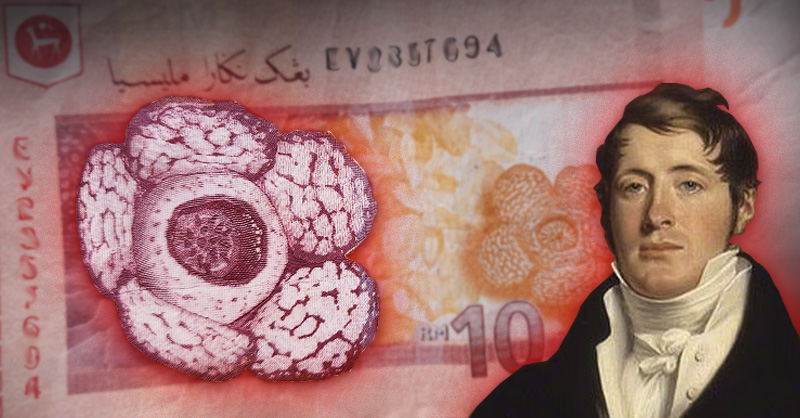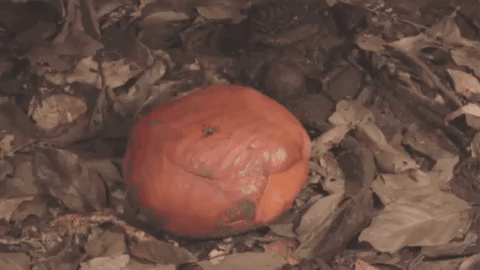Why this smelly parasitic flower is named after Singapore’s founder

- 101Shares
- Facebook92
- LinkedIn3
- Email3
- WhatsApp3
Even if you’re not Malaysian, you probably know what a rafflesia looks like. If you don’t, pull out a 10 ringgit note and you’ll see one. It’s a strange plant in many ways – it looks and smells like rotten meat, it’s a parasite to another kind of parasite, the only thing you see of it is the huge flower, and one particular species is even known to produce and maintain body heat, much like mammals. Creepy.
It’s no wonder, then, that the rafflesia got famous enough to frequently make it into pop culture, for example as a recurring inspiration for enemies in the Final Fantasy series.

One of the earlier iterations. Img from Highwater Labs.
Okay, maybe just the name is popular. But the name rafflesia is iconic enough to evoke images of large, creepy flowers – a trademark of sorts. So how did such a swishy, tropical-sounding name come about? Perhaps ironically…
Rafflesia was actually based on a not-so-tropical angmoh’s name
Some of you might have already guessed it, but there’s a ‘Raffles’ hiding in ‘Rafflesia’. Specifically, Stamford Raffles, the guy who founded modern Singapore. Raffles appeared to have an interest in local biology, having named several local species during his stint in Southeast Asia. As the story goes, sometime in the early 1800s he sponsored an exploration trip in Pulau Lebar (somewhere in Indonesia today). One of the local servants found a huge flower in the forest, and led Raffles’ doctor/naturalist, a Dr Joseph Arnold, to it.
Struck by the strangeness of it – he described seeing “a swarm of flies hovering over” and laying eggs in the flower, which smelled like “tainted beef” – Arnold extracted the flower and sent it back to town. He also made a colored drawing of the flower, which was lucky as by the end of the journey, the flower had turned brown and had maggots crawling over it.

They don’t have iceboxes back then. Gif from Giphy.
Unfortunately, Arnold died a few months later due to malaria. His specimen and drawing, however, made it to London into the hands of Robert Brown, a big name in natural history at the time. Brown published a paper on the discovery of a new group of plants, and he proposed the giant flower to be named Rafflesia arnoldi; to honor Raffles who sponsored the trip, and Arnold who helped. The discovery was well-received, and the name stuck ever since. However, it seems that Raffles himself wanted to name the flower Rafflesia titan, as he had instructed Arnold’s replacement to rush out another paper at the same time. That name didn’t get used, as Brown’s paper got read first.
Interestingly, there might be a reason why they rushed so much to send in two separate papers on the same flower…
The British allegedly already knew about the flower long before the ‘discovery’
So Raffles’ team, as the world discovered much later, wasn’t the first European to have seen the rafflesia. The credit belonged to Louis-Auguste Deschamps, a French surgeon and botanist who saw the flower in the 1790s, about 20 years before it was named. Deschamps and his crew were sailing around during the French upheaval, looking for a lost research ship. After four years, they gave up on the search and were harbored in Surabaya (East Java), not wanting to go home due to the political situation.
The Dutch colonial authorities then confined them there, and the Governor, seeing that Deschamps had a great interest in the local language, people, and plants, invited him to document the natural history of Java. With the help of assistants, Deschamps happily spent the next three years going all over the place collecting specimens, making drawings, and describing the local plants, even starting a manuscript titled “Materials towards a Flora of Java“. In 1798, Deschamps was allowed to sail back to France with his treasures, but France was at war with British at the time. Deschamps’ ship ran into a British blockade and his research materials, along with the ship, was confiscated.

Gif from Gifer.
Nobody knew what happened to Deschamps’ manuscripts then, but after the discovery of the rafflesia was announced, it started making an appearance again. They showed up at a public sale in London in 1861 and were donated to the British Museum, where it was finally looked at by some researchers in 1954, almost 100 years later. In it were sketches of rafflesia’s buds and their host plants, proving that Deschamps did discover the rafflesia first.
Due to the circumstances, it was suspected that British botanists did get a look at Deschamps’ manuscripts after they were confiscated, and so they were aware of rafflesia’s existence – they just needed to be the first to publish it. At the time, there was a rivalry between the French, the British and the Dutch, which is perhaps why Raffles rushed Arnold’s replacement to write another paper and submit it at around the same time; regardless of whichever paper got read first, the discoverer will be a British botanist.

Cabbage? No, rafflesia. Gif from Gifer.
Deschamps isn’t that famous today – his Wikipedia page, even, is embarrassingly bare – and it seems he settled down as a surgeon in his native town after the ordeal, keeping botany as a hobby. But someone did recognize him, and named a genus of grasses Deschampia in his honor, which is nice.
As for the Malay vernacular name, bunga pakma, well… pakma is a Sanskrit-based word that means lotus, so perhaps it’s called that in Malay and Indonesian due to it resembling a lotus from hell or something.
- 101Shares
- Facebook92
- LinkedIn3
- Email3
- WhatsApp3
